Bartle's Psychotypes and Audience Balancing
A few decades ago, a professor at the University of Essex, Richard Alan Bartl, invented a model of segmentation of players according to psychological types. Today, it is used by game developers all over the world, including the Mail.Ru Group. For example, Bartle's psycho-types are used in social networks to optimize the catalog of games for each user. So what did this wonderful man come up with?
30 years ago, Bartle wrote one of the first multiplayer games - MUD (Multi-User Dungeon), by whose name the whole genre is now called. In fact, it is the progenitor of all modern MMOs. Here is such a great console text game:

')
What Bartle relies on is the program code of the game, printed to protect scientific work.
What is Multi-User Dungeon? This is most often translated into Russian as “multiplayer worlds” (MMM). A game on any platform can be called a multiplayer world if it satisfies three main criteria:
What we today mean by modern MMOs can, with a stretch, be called MPM. They fully satisfy the first two conditions, but only partially fit the latter: the creation of content by players. Ultima Online, RuneScape and even Minecraft, which is currently popular, can be attributed to the classic MMM.
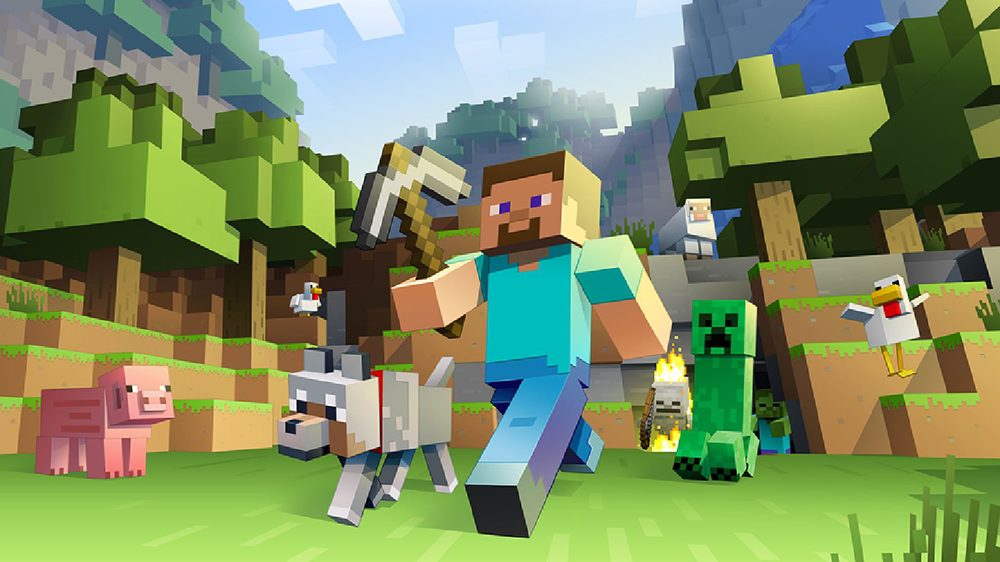
In modern MMOs - Warcraft, Lineage, Perfect World, ArcheAge, Skyforge - players cannot create the world themselves or are limited in this process.
At one time, Bartle wondered, “What is interesting to people? Why do they come to play multiplayer games? ". Trying to understand the motivation of the players, he singled out two scales: “action - interaction” and “players - the world”. The place of their intersection, he called the plane of interest. Some players are looking for interaction with other players in the mass games. The latter want to act in person, taking away the benefits from the world or the participants in the game. The third ones are attracted by the game universe itself: the opportunities opening up in it, the environment, objects, mechanics, etc. Someone interested in in-game chatting, and the gameplay itself is secondary.
Based on these observations, Bartl identified the following psycho-types, or groups of players:
Let's take a closer look at each class in order to better understand the motivation of these people - why they come to our games, what they want to find in them.
Their majority, an average of 40% of users. This value is highly dependent on a specific project: in some game it is 10-20%, and somewhere all 50%. And although among Russian-speaking audience there are traditionally many Killers (more than the world average), Careerists remain the most numerous type. They value power, wealth, and status.
Careerists love to get all sorts of game benefits. They produce a lot of resources, produce a lot of things. But the greatest satisfaction is obtained from various awards, medals, stripes for all sorts of achievements. Achieving their goals, solving more and more difficult and complex tasks that lead to a long-awaited reward - that is what brings them pleasure. That is, Careerists stimulates in-game growth, progress.
Careerists are willing to pay to accelerate their development, to have time and additional opportunities. But in order to be simply better than others, they will not forked. It is important for them to prove their superiority by their own efforts. Most of all, the Drive likes different variations on the theme “spend time - get reward”.
Careerists are well monetized and have a good retention - an indicator of user retention in the game.

Their minority. On average around the world about 10%. But a number of national markets are a little different in this indicator in a big way: Russia, Turkey and South Korea. Killers value strength, skill, influence, domination. Please note that the influence is appreciated by Careerists. But the skill, as will be shown below, is also appreciated by Researchers. There are certain intersections for all purposes between all classes, because they have intersecting faces on the plane of interest. But their motivation is different.
Killers love competitions, tournaments and ratings. This allows them to prove that they are cooler than others, that they are superior to someone. Therefore, they like everything related to direct interaction with other players. In MMO games, Killers love PvP, in more peaceful "farms" they are crazy about their neighbors' ratings and comparisons with friends. For example, all sorts of competition modes with people they know in games are made primarily for Killers. “My friend has 2 cm more? No, I will play more, so it is impossible. " Here we see the intersection of this group with the Socialists, who also love the ratings of friends and interaction with them. But they have slightly different goals.
Killers are the most monetized audience, they are willing to pay to kill, conquer and dominate. However, the retreat of this group is quite average.
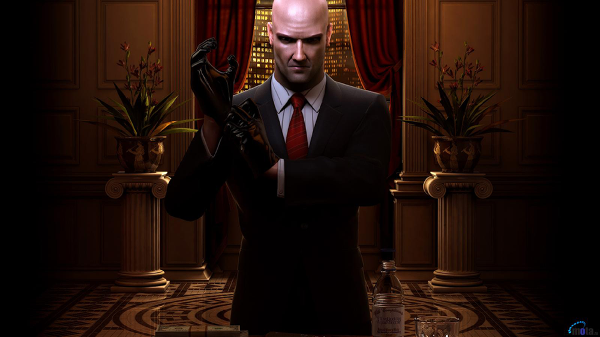
The best reason for the Researcher to come into your game is a large selection of game mechanics, a challenge for the mind and a variety of content. Researchers love game reviews. They need to be convinced that your game is really good and worth the time spent. Like Killers, they value skill. At the same time, this class is focused on knowledge, on the absorption of game content, on the study of game mechanics and game capabilities. The bigger the game world, the better. It is important for Researchers to develop unique sets of talents in order to be able to learn all the permissible combinations, hidden aspects, nuances, etc. They also love quests, dialogues, the plot that stirs their interest.
Researchers have the maximum value of retention, and if you managed to lure them into the game, they will be sufficiently committed to it, while the project throws up calls to them. However, the financial performance of this group is not the best. Researchers are difficult to provoke a spontaneous payment. Often they are better off than others to subscribe, they appreciate a certain element of integrity. If these people come to the project, they will hold on to it, this is a dedicated audience, albeit poorly monetized. They often write on the forums that the game is flawed and insufficiently diverse, but at the same time defend it before attacks by representatives of other psycho-types.

They love communication, relationships, popularity. They love to stand out. And here you need to compare them with all other psycho-types: the share of pride is inherent in all people. Killers pride themselves on dominating others; Accumulators - by the fact that they have the most resources and benefits; Researchers - because they are smarter than others, and Sotsialshchiki - because they are more popular. Therefore, when we give players the opportunity to stand out, compete with each other, compete, it always benefits the project.
Sotsialshchikam necessarily need contests, chats, meetings, events, forums. Everything related to mass interaction. This is a fertile class, but not without problems. Firstly, they, like Researchers, are monetized rather poorly. Basically, they like to buy the appearance - that is, the appearance, beautiful costumes, etc. At the same time, Sotsialshchiki have the minimum retention among all classes, that is, they are the hardest to keep. They came, they played, they went into another game. They are supported by promotions and game events. Often they bring a lot of friends into the game, among which there can be a very paying Killer. By the way, among the Chinese, the share of Sotsialshchikov is slightly higher than in Western countries. On average, the world share of researchers and social workers are quite close.

It would seem that if Sotsialshchiki and Researchers pay less, why do we need them at all? There are not so many of them in comparison with the Careerists. Let few killers, but they bring a lot of money. This question is not as simple as it seems. What is important is not so much the number of representatives of each psychotype in the project, but the ratio between them. As already mentioned, it is highly dependent on the game. For example, in Perfect World, Researchers and Socialists total less than 25%, and Killers and Careerists make up the majority. The World of Warcraft Killer least of all - about 15%, and the share of Careerists fluctuated around 35%.
A good game gives all four psycho-types the opportunity for self-realization. But if some psychotype lacks the necessary features, then its representatives can manifest themselves as representatives of another psychotype. Why it happens? No man is a 100% Killer, a Social worker, etc. In each of us there are traits inherent in all four psycho-types, just at one particular moment of time any one prevails. Psycho-types are not a characteristic of the player, but a certain pattern of behavior. People manifest different qualities depending on the particular game and changing circumstances.
We conducted a study, setting the task to find out what features representatives of different psycho types love, what annoys them, what they like to play. More than 10,000 players and about 100 employees of gaming companies were polled. And we saw an interesting trend: it turned out that at least the average audience among the players is more than the Careerists, but here game developers are dominated by Researchers. It is possible that the latter factor affects the games we create. Probably, we bring to them what we like the most in games. And this must be taken into account, because the game of our dreams and the game of dreams of our players are two completely different projects.
Here is how the answers of the research participants were distributed on the example of the “clans” feature. Players could choose one of seven answer choices: from "this thing is absolutely necessary for me" to "this thing enrages me."
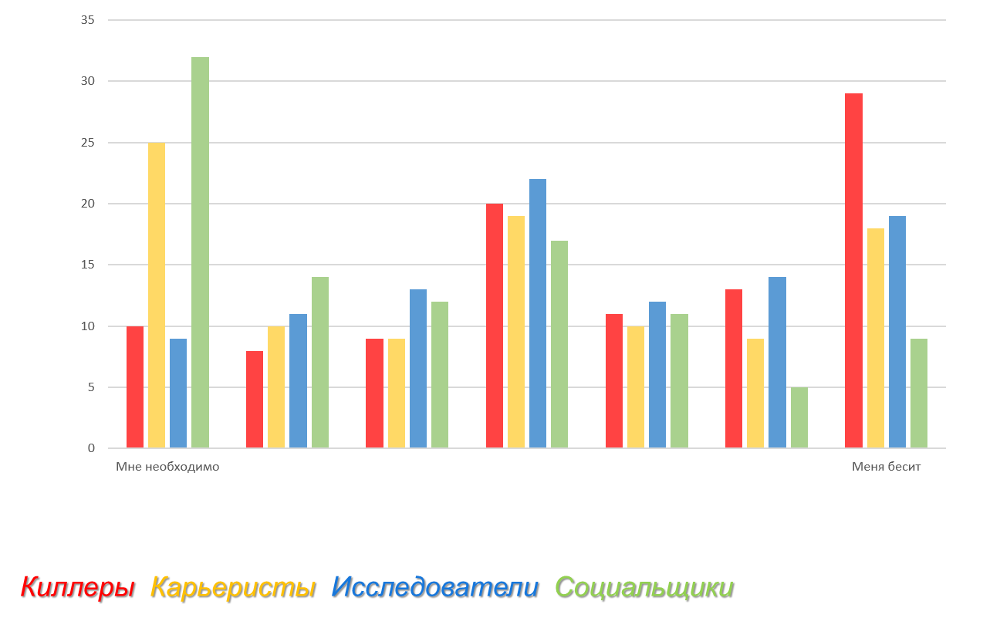
As you can see, the distribution turned out quite interesting. Clans are necessary first of all to the Careerists and the Socialists, which is completely logical. Socialists want to chat, and the clan gives them this opportunity. While careerists see in the clan the opportunity to use its resources to achieve their goals: to go with their comrades on the battlefield, dungeon or somewhere else, to perform tasks that they can not pass without a clan.
Now, let's see what the 10,000 people interviewed by us, based on Bartle’s psycho-types, hate.
Killers hate routine: click on the mines a la Clash of Clans, look for resources. If there are 20 of these mines, the Killer will give up the game, accusing it of “zadrotstvo.” If one or two mines, then most likely it is acceptable to him. Killers do not like social interaction. In this regard, they are a kind of opposition to Sotsialshchikam, so they are not interested in communication and friends from social networks. They are enraged by clans, they are by nature alone. Killers love to act independently, rarely get together in teams and only for the sake of achieving a specific goal. Killers are annoying encyclopedias, guides, tutorials.
Careerists do not like to buy for real money something achievable by in-game funds. They perceive this as an element of foul play and waste of resources. When the Killer kills the Career Player, he says: “What do you mean ?! This is a game about PVP - they kill me, they bend me, it's not fair. ” And when the Killer kills another Careerist, the first killed says: "These are the rules of the game, this is normal." Careerists do not like to lose anything. I have a friend who has been playing an old browser game without graphics for 15 years. I sometimes ask him: “Why do you play it?” He replies: “There I have accumulated 2.5 million ores, where will I now leave this game? I already have them, but I will not abandon them. ” Therefore, the best careerist in the game delays the ability to save endlessly. And if this person has paid you even once, then he becomes your loyal audience. For his 24 rubles, which he spent on your project instead of a bun in the dining room, he will hold on to your game for a long time.
Researchers do not like clan battles, marathon activities. From the point of view of Sotsialshchik, a researcher is such an unsociable, gloomy man who despises society, a social phobia. Researchers don't like ratings. A curious detail: many representatives of this class consider Killers as underdeveloped Researchers - they say that they were simply disappointed in life, they were silly, they wanted to explore the world, but they did not succeed, and they began to kill and take revenge on everyone. But the cool Killers Researchers consider unnecessary players who do not understand the meaning of life, which consists in science, the acquisition of knowledge, truth and a great miracle. And so they simply ignore them.
Social workers do not like to attack each other. Usually they are quite peaceful. But not always. For example, many of the Dota 2 trolls are Sotsialshchiki. They all tell you what they think about you. However, they do not like to directly attack. Like Careerists, Sotsialshchiki do not like to pay, speed up something for money. And they do not like to make difficult choices. When you give a variety of opportunities, Sotsialshchik is likely to scare.
This illustration shows how the number of representatives of different psycho types varies depending on the change in the proportion of other psycho types.
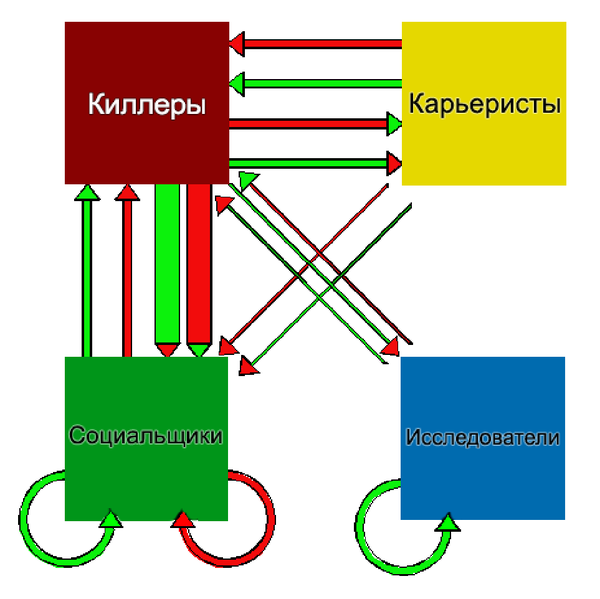
For example, an increase in the number of Sotsialshchikov leads to the fact that they begin to pull in the project other members of the same class. That is, the more Socialists in the game, the more they invite their friends. With a decrease in the critical mass, the collapse and mass withdrawal of the Sotsialshchiki from the project is possible. Also, if Killer becomes larger, the number of Careerists decreases.
Richard Alan Bartle, when he invented the whole system, made several far-reaching conclusions regarding balancing the audience. To maximize the revenue from the game and increase the retention of the project, we need to maintain a good correlation of psycho-types. And here we will be helped by several scenarios developed by Bartle and his followers.
The first scenario is a stable balance, when the ratio between all psycho-types almost never changes and the share of each of them is quite large. This is convenient in terms of game design. But this scenario has a flaw: the absolute balance is extremely poorly compatible with the free2play model and the constant need to catch up with fresh traffic. Slightly better this script works with a subscription. It offers high retention, which is easily broken by monetization. Example: World of Warcraft.
The second scenario: the balance of Killers and Careerists. The idea is that the majority of players are careerists who bring profit from sharpening, objects and boosts. They can provide more than a third of all revenue. The share of Killers in this scenario should be significantly higher than in other projects. This is exactly the key to success. In this case, Killers bring in almost 2/3 of the proceeds. At the same time, there are not so many Socialists and Researchers here. Example: Perfect World.
The third scenario: the dominance of the Sotsialshchikov. Quite a popular option. Very simple in terms of game design, but not very profitable financially. The critical mass of Sotsialshchikov allows you to constantly maintain a large audience. The easiest option to destroy this model is to turn off traffic. The number of Sotsialshchikov falls, the critical mass is lost, the game dies. Its easy enough to kill the usual rejection of marketing. But on the other hand, such a model is resistant to shocks, mistakes in promotions, events and marathons, because the Socialists perceive this as part of the game. Example: Para Pa: City of Dances.
The fourth scenario: the domination of Researchers. There are not so many researchers among the players - up to 30%. In this scenario, their share reaches 50%. They are hard to lure into new games, but they play long enough. They can play your project, even when you abandoned marketing, and they will pay by inertia. This is a very good self-sustaining project, for which the publication of news once a month is an acceptable activity to sustain life. Example: browser game Retaliation.
How can a multiplayer game die? Very often, the collapse begins with Killers. If you give them the opportunity to play more actively, to stimulate world PvP, allowing them to cut out all the players with impunity, they will begin to put pressure on the Careerists, as the most numerous class. Careerists immediately vzvuyut on all chat rooms, forums: "What do you mean ?! They kill us. They interfere with playing! ”- and they will start to leave. With the departure of Careerists, their share in the project is reduced. So, the relative percentage of social workers is growing. And they are increasingly becoming targets of Killers. As we know, this situation will not suit them for long. , . , , , . , . . . - . — . . . : « ». . .
3 . , , , , .
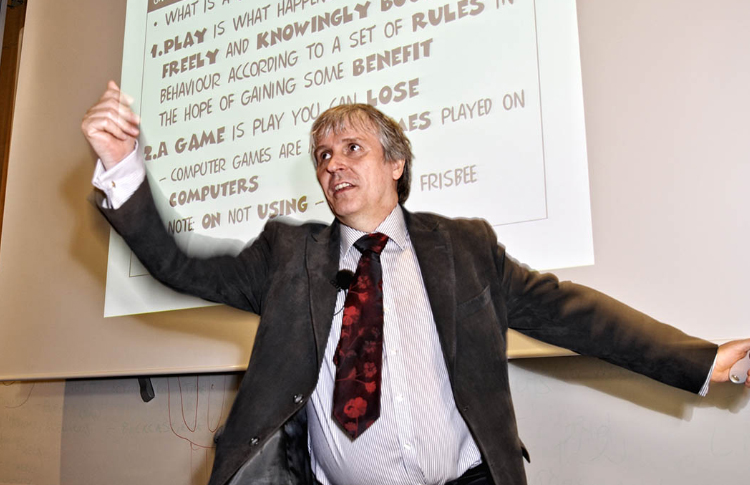
— 100%. C, 20% , 30% , .. , 30% . , 40.
— . , . , . , . – . , UX- Mail.Ru Group . — , .
, — , 4 . — «»; 24 — +10 ; « » — +1 +3 . . : 20% , 30% — .. , . , . , . , – . , . . , , - . : , , . , , – .

4 , . , . . , , “Explicit — Implicit”. « — ». .
. , «» — , . , , «» (). , . , . , , - . «» , , , .
«» (Planners), , «». «, , , - » — , .

, , , «». , , -, , . , , , - . , , «». , , . , . , .
«» (Networker) «». — , , . , , , , . , , , . — , : «, , , , , , ».
, « — ». . , . ? , , ? 8- , .
, BrainHex. « ». : - . — . , :
That's all. , .
, :
30 years ago, Bartle wrote one of the first multiplayer games - MUD (Multi-User Dungeon), by whose name the whole genre is now called. In fact, it is the progenitor of all modern MMOs. Here is such a great console text game:

')
What Bartle relies on is the program code of the game, printed to protect scientific work.
What is Multi-User Dungeon? This is most often translated into Russian as “multiplayer worlds” (MMM). A game on any platform can be called a multiplayer world if it satisfies three main criteria:
- It must be infinite, such a game can not "pass."
- A lot of active players participate in it: thousands, tens of thousands.
- Players have the ability to independently create game content.
What we today mean by modern MMOs can, with a stretch, be called MPM. They fully satisfy the first two conditions, but only partially fit the latter: the creation of content by players. Ultima Online, RuneScape and even Minecraft, which is currently popular, can be attributed to the classic MMM.

In modern MMOs - Warcraft, Lineage, Perfect World, ArcheAge, Skyforge - players cannot create the world themselves or are limited in this process.
At one time, Bartle wondered, “What is interesting to people? Why do they come to play multiplayer games? ". Trying to understand the motivation of the players, he singled out two scales: “action - interaction” and “players - the world”. The place of their intersection, he called the plane of interest. Some players are looking for interaction with other players in the mass games. The latter want to act in person, taking away the benefits from the world or the participants in the game. The third ones are attracted by the game universe itself: the opportunities opening up in it, the environment, objects, mechanics, etc. Someone interested in in-game chatting, and the gameplay itself is secondary.
Based on these observations, Bartl identified the following psycho-types, or groups of players:
- Drives (Achievers). Also found the name Careerists. For them it is important to accumulate power, money, cool artifacts - any game goods and resources.
- Killers (Killers). For them, the main motivation is superiority over other players, dominance, dominance. They only want to win.
- Explorers. They are interested to study the game world and reveal its secrets. They do not pursue action and battles.
- Socialists. They are also called Party People. For them, it is important to communicate with other players, social interaction and mutual understanding.
Let's take a closer look at each class in order to better understand the motivation of these people - why they come to our games, what they want to find in them.
Drives (or Careerists)
Their majority, an average of 40% of users. This value is highly dependent on a specific project: in some game it is 10-20%, and somewhere all 50%. And although among Russian-speaking audience there are traditionally many Killers (more than the world average), Careerists remain the most numerous type. They value power, wealth, and status.
Careerists love to get all sorts of game benefits. They produce a lot of resources, produce a lot of things. But the greatest satisfaction is obtained from various awards, medals, stripes for all sorts of achievements. Achieving their goals, solving more and more difficult and complex tasks that lead to a long-awaited reward - that is what brings them pleasure. That is, Careerists stimulates in-game growth, progress.
Careerists are willing to pay to accelerate their development, to have time and additional opportunities. But in order to be simply better than others, they will not forked. It is important for them to prove their superiority by their own efforts. Most of all, the Drive likes different variations on the theme “spend time - get reward”.
Careerists are well monetized and have a good retention - an indicator of user retention in the game.

Killers
Their minority. On average around the world about 10%. But a number of national markets are a little different in this indicator in a big way: Russia, Turkey and South Korea. Killers value strength, skill, influence, domination. Please note that the influence is appreciated by Careerists. But the skill, as will be shown below, is also appreciated by Researchers. There are certain intersections for all purposes between all classes, because they have intersecting faces on the plane of interest. But their motivation is different.
Killers love competitions, tournaments and ratings. This allows them to prove that they are cooler than others, that they are superior to someone. Therefore, they like everything related to direct interaction with other players. In MMO games, Killers love PvP, in more peaceful "farms" they are crazy about their neighbors' ratings and comparisons with friends. For example, all sorts of competition modes with people they know in games are made primarily for Killers. “My friend has 2 cm more? No, I will play more, so it is impossible. " Here we see the intersection of this group with the Socialists, who also love the ratings of friends and interaction with them. But they have slightly different goals.
Killers are the most monetized audience, they are willing to pay to kill, conquer and dominate. However, the retreat of this group is quite average.

Researchers
The best reason for the Researcher to come into your game is a large selection of game mechanics, a challenge for the mind and a variety of content. Researchers love game reviews. They need to be convinced that your game is really good and worth the time spent. Like Killers, they value skill. At the same time, this class is focused on knowledge, on the absorption of game content, on the study of game mechanics and game capabilities. The bigger the game world, the better. It is important for Researchers to develop unique sets of talents in order to be able to learn all the permissible combinations, hidden aspects, nuances, etc. They also love quests, dialogues, the plot that stirs their interest.
Researchers have the maximum value of retention, and if you managed to lure them into the game, they will be sufficiently committed to it, while the project throws up calls to them. However, the financial performance of this group is not the best. Researchers are difficult to provoke a spontaneous payment. Often they are better off than others to subscribe, they appreciate a certain element of integrity. If these people come to the project, they will hold on to it, this is a dedicated audience, albeit poorly monetized. They often write on the forums that the game is flawed and insufficiently diverse, but at the same time defend it before attacks by representatives of other psycho-types.

Social workers
They love communication, relationships, popularity. They love to stand out. And here you need to compare them with all other psycho-types: the share of pride is inherent in all people. Killers pride themselves on dominating others; Accumulators - by the fact that they have the most resources and benefits; Researchers - because they are smarter than others, and Sotsialshchiki - because they are more popular. Therefore, when we give players the opportunity to stand out, compete with each other, compete, it always benefits the project.
Sotsialshchikam necessarily need contests, chats, meetings, events, forums. Everything related to mass interaction. This is a fertile class, but not without problems. Firstly, they, like Researchers, are monetized rather poorly. Basically, they like to buy the appearance - that is, the appearance, beautiful costumes, etc. At the same time, Sotsialshchiki have the minimum retention among all classes, that is, they are the hardest to keep. They came, they played, they went into another game. They are supported by promotions and game events. Often they bring a lot of friends into the game, among which there can be a very paying Killer. By the way, among the Chinese, the share of Sotsialshchikov is slightly higher than in Western countries. On average, the world share of researchers and social workers are quite close.

Class comparison
It would seem that if Sotsialshchiki and Researchers pay less, why do we need them at all? There are not so many of them in comparison with the Careerists. Let few killers, but they bring a lot of money. This question is not as simple as it seems. What is important is not so much the number of representatives of each psychotype in the project, but the ratio between them. As already mentioned, it is highly dependent on the game. For example, in Perfect World, Researchers and Socialists total less than 25%, and Killers and Careerists make up the majority. The World of Warcraft Killer least of all - about 15%, and the share of Careerists fluctuated around 35%.
A good game gives all four psycho-types the opportunity for self-realization. But if some psychotype lacks the necessary features, then its representatives can manifest themselves as representatives of another psychotype. Why it happens? No man is a 100% Killer, a Social worker, etc. In each of us there are traits inherent in all four psycho-types, just at one particular moment of time any one prevails. Psycho-types are not a characteristic of the player, but a certain pattern of behavior. People manifest different qualities depending on the particular game and changing circumstances.
We conducted a study, setting the task to find out what features representatives of different psycho types love, what annoys them, what they like to play. More than 10,000 players and about 100 employees of gaming companies were polled. And we saw an interesting trend: it turned out that at least the average audience among the players is more than the Careerists, but here game developers are dominated by Researchers. It is possible that the latter factor affects the games we create. Probably, we bring to them what we like the most in games. And this must be taken into account, because the game of our dreams and the game of dreams of our players are two completely different projects.
Here is how the answers of the research participants were distributed on the example of the “clans” feature. Players could choose one of seven answer choices: from "this thing is absolutely necessary for me" to "this thing enrages me."

As you can see, the distribution turned out quite interesting. Clans are necessary first of all to the Careerists and the Socialists, which is completely logical. Socialists want to chat, and the clan gives them this opportunity. While careerists see in the clan the opportunity to use its resources to achieve their goals: to go with their comrades on the battlefield, dungeon or somewhere else, to perform tasks that they can not pass without a clan.
Now, let's see what the 10,000 people interviewed by us, based on Bartle’s psycho-types, hate.
Killers hate routine: click on the mines a la Clash of Clans, look for resources. If there are 20 of these mines, the Killer will give up the game, accusing it of “zadrotstvo.” If one or two mines, then most likely it is acceptable to him. Killers do not like social interaction. In this regard, they are a kind of opposition to Sotsialshchikam, so they are not interested in communication and friends from social networks. They are enraged by clans, they are by nature alone. Killers love to act independently, rarely get together in teams and only for the sake of achieving a specific goal. Killers are annoying encyclopedias, guides, tutorials.
Careerists do not like to buy for real money something achievable by in-game funds. They perceive this as an element of foul play and waste of resources. When the Killer kills the Career Player, he says: “What do you mean ?! This is a game about PVP - they kill me, they bend me, it's not fair. ” And when the Killer kills another Careerist, the first killed says: "These are the rules of the game, this is normal." Careerists do not like to lose anything. I have a friend who has been playing an old browser game without graphics for 15 years. I sometimes ask him: “Why do you play it?” He replies: “There I have accumulated 2.5 million ores, where will I now leave this game? I already have them, but I will not abandon them. ” Therefore, the best careerist in the game delays the ability to save endlessly. And if this person has paid you even once, then he becomes your loyal audience. For his 24 rubles, which he spent on your project instead of a bun in the dining room, he will hold on to your game for a long time.
Researchers do not like clan battles, marathon activities. From the point of view of Sotsialshchik, a researcher is such an unsociable, gloomy man who despises society, a social phobia. Researchers don't like ratings. A curious detail: many representatives of this class consider Killers as underdeveloped Researchers - they say that they were simply disappointed in life, they were silly, they wanted to explore the world, but they did not succeed, and they began to kill and take revenge on everyone. But the cool Killers Researchers consider unnecessary players who do not understand the meaning of life, which consists in science, the acquisition of knowledge, truth and a great miracle. And so they simply ignore them.
Social workers do not like to attack each other. Usually they are quite peaceful. But not always. For example, many of the Dota 2 trolls are Sotsialshchiki. They all tell you what they think about you. However, they do not like to directly attack. Like Careerists, Sotsialshchiki do not like to pay, speed up something for money. And they do not like to make difficult choices. When you give a variety of opportunities, Sotsialshchik is likely to scare.
Balance between psycho
This illustration shows how the number of representatives of different psycho types varies depending on the change in the proportion of other psycho types.

For example, an increase in the number of Sotsialshchikov leads to the fact that they begin to pull in the project other members of the same class. That is, the more Socialists in the game, the more they invite their friends. With a decrease in the critical mass, the collapse and mass withdrawal of the Sotsialshchiki from the project is possible. Also, if Killer becomes larger, the number of Careerists decreases.
Richard Alan Bartle, when he invented the whole system, made several far-reaching conclusions regarding balancing the audience. To maximize the revenue from the game and increase the retention of the project, we need to maintain a good correlation of psycho-types. And here we will be helped by several scenarios developed by Bartle and his followers.
The first scenario is a stable balance, when the ratio between all psycho-types almost never changes and the share of each of them is quite large. This is convenient in terms of game design. But this scenario has a flaw: the absolute balance is extremely poorly compatible with the free2play model and the constant need to catch up with fresh traffic. Slightly better this script works with a subscription. It offers high retention, which is easily broken by monetization. Example: World of Warcraft.
The second scenario: the balance of Killers and Careerists. The idea is that the majority of players are careerists who bring profit from sharpening, objects and boosts. They can provide more than a third of all revenue. The share of Killers in this scenario should be significantly higher than in other projects. This is exactly the key to success. In this case, Killers bring in almost 2/3 of the proceeds. At the same time, there are not so many Socialists and Researchers here. Example: Perfect World.
The third scenario: the dominance of the Sotsialshchikov. Quite a popular option. Very simple in terms of game design, but not very profitable financially. The critical mass of Sotsialshchikov allows you to constantly maintain a large audience. The easiest option to destroy this model is to turn off traffic. The number of Sotsialshchikov falls, the critical mass is lost, the game dies. Its easy enough to kill the usual rejection of marketing. But on the other hand, such a model is resistant to shocks, mistakes in promotions, events and marathons, because the Socialists perceive this as part of the game. Example: Para Pa: City of Dances.
The fourth scenario: the domination of Researchers. There are not so many researchers among the players - up to 30%. In this scenario, their share reaches 50%. They are hard to lure into new games, but they play long enough. They can play your project, even when you abandoned marketing, and they will pay by inertia. This is a very good self-sustaining project, for which the publication of news once a month is an acceptable activity to sustain life. Example: browser game Retaliation.
How can a multiplayer game die? Very often, the collapse begins with Killers. If you give them the opportunity to play more actively, to stimulate world PvP, allowing them to cut out all the players with impunity, they will begin to put pressure on the Careerists, as the most numerous class. Careerists immediately vzvuyut on all chat rooms, forums: "What do you mean ?! They kill us. They interfere with playing! ”- and they will start to leave. With the departure of Careerists, their share in the project is reduced. So, the relative percentage of social workers is growing. And they are increasingly becoming targets of Killers. As we know, this situation will not suit them for long. , . , , , . , . . . - . — . . . : « ». . .
3 . , , , , .
- . , , , , , . , « ». , . , , . , 8 World of Warcraft PvP. - . , , , . , , , , . , : « … ».
- . , . . , , , . , .
- . , . , , .

?
— 100%. C, 20% , 30% , .. , 30% . , 40.
— . , . , . , . – . , UX- Mail.Ru Group . — , .
, — , 4 . — «»; 24 — +10 ; « » — +1 +3 . . : 20% , 30% — .. , . , . , . , – . , . . , , - . : , , . , , – .

4 , . , . . , , “Explicit — Implicit”. « — ». .
. , «» — , . , , «» (). , . , . , , - . «» , , , .
«» (Planners), , «». «, , , - » — , .

, , , «». , , -, , . , , , - . , , «». , , . , . , .
«» (Networker) «». — , , . , , , , . , , , . — , : «, , , , , , ».
, « — ». . , . ? , , ? 8- , .
, BrainHex. « ». : - . — . , :
- Seeker : , , , .
- Survivor : , - . , ( , ) ( , ).
- Daredevil : , , , — , , , , .
- Mastermind : . , , . , , .
- Conqueror : , , . , .
- Socialiser : , .
- Achiever : .
That's all. , .
, :
- Designing Virtual Worlds. — Richard A. Bartle, 2003. www.amazon.com/Designing-Virtual-Worlds-Richard-Bartle/dp/0131018167
- mud.co.uk/richard/imucg.htm
- Brainhex. , : blog.brainhex.com
Source: https://habr.com/ru/post/263839/
All Articles